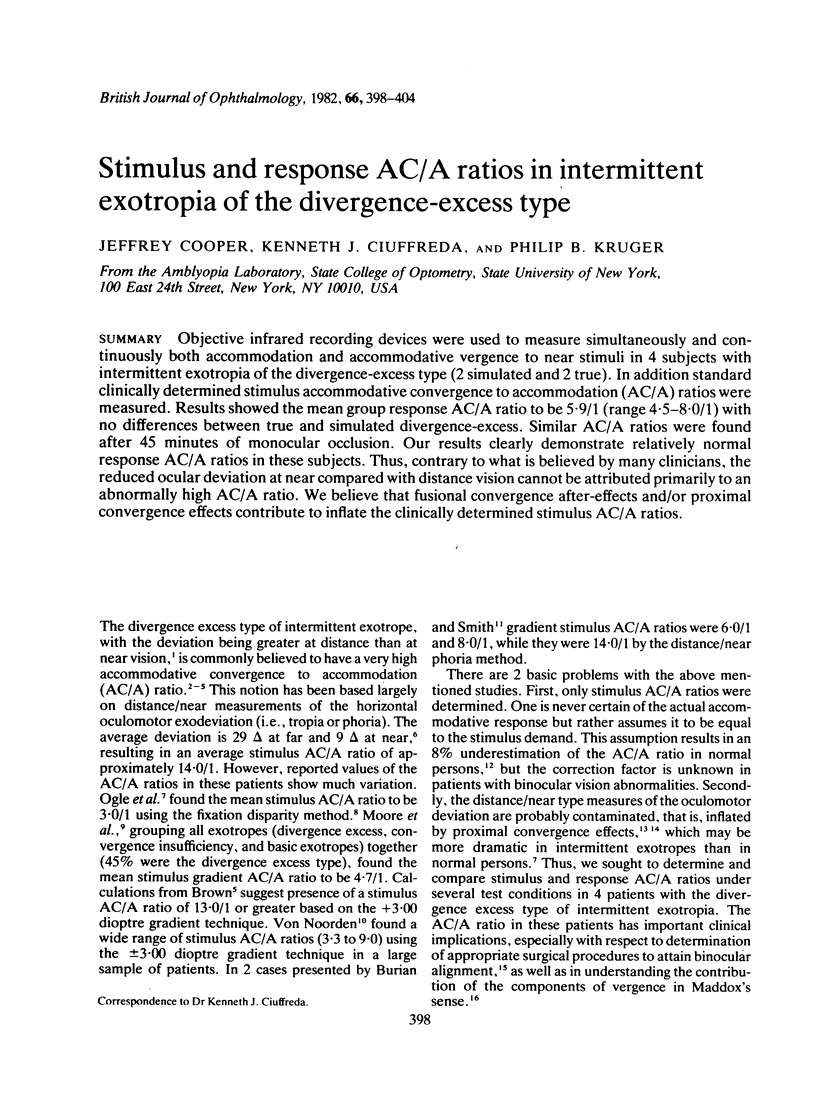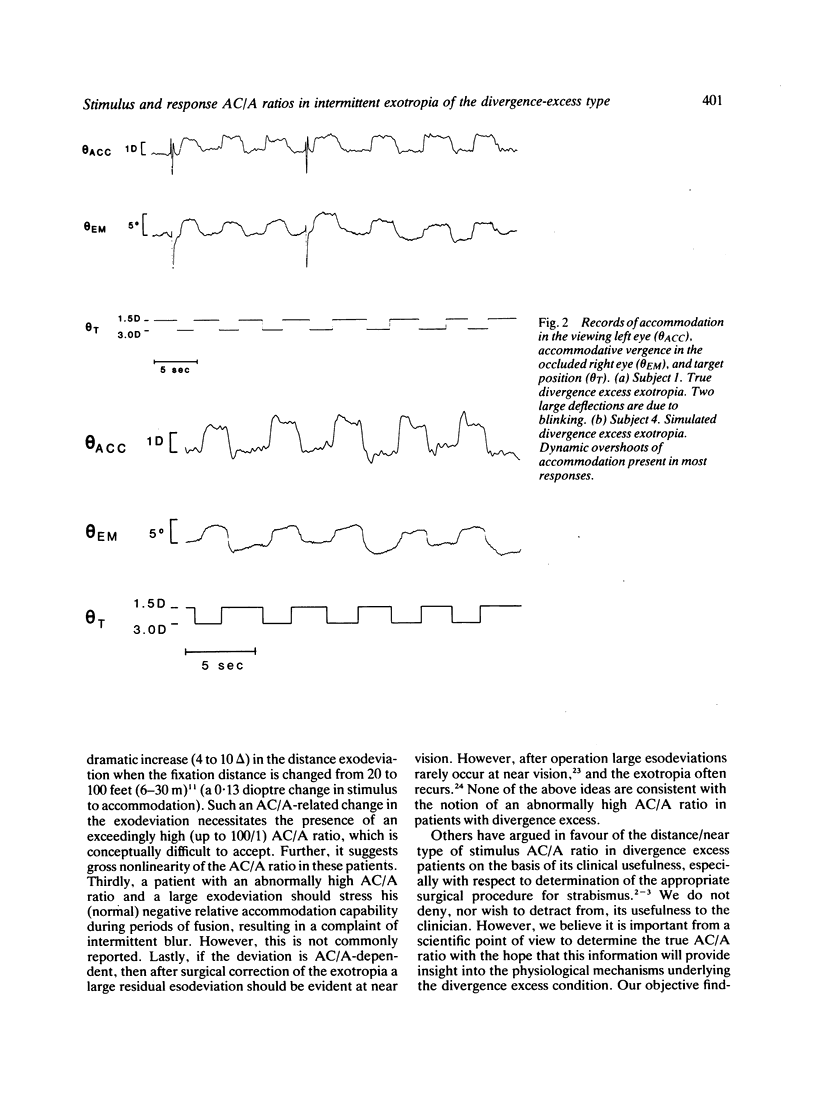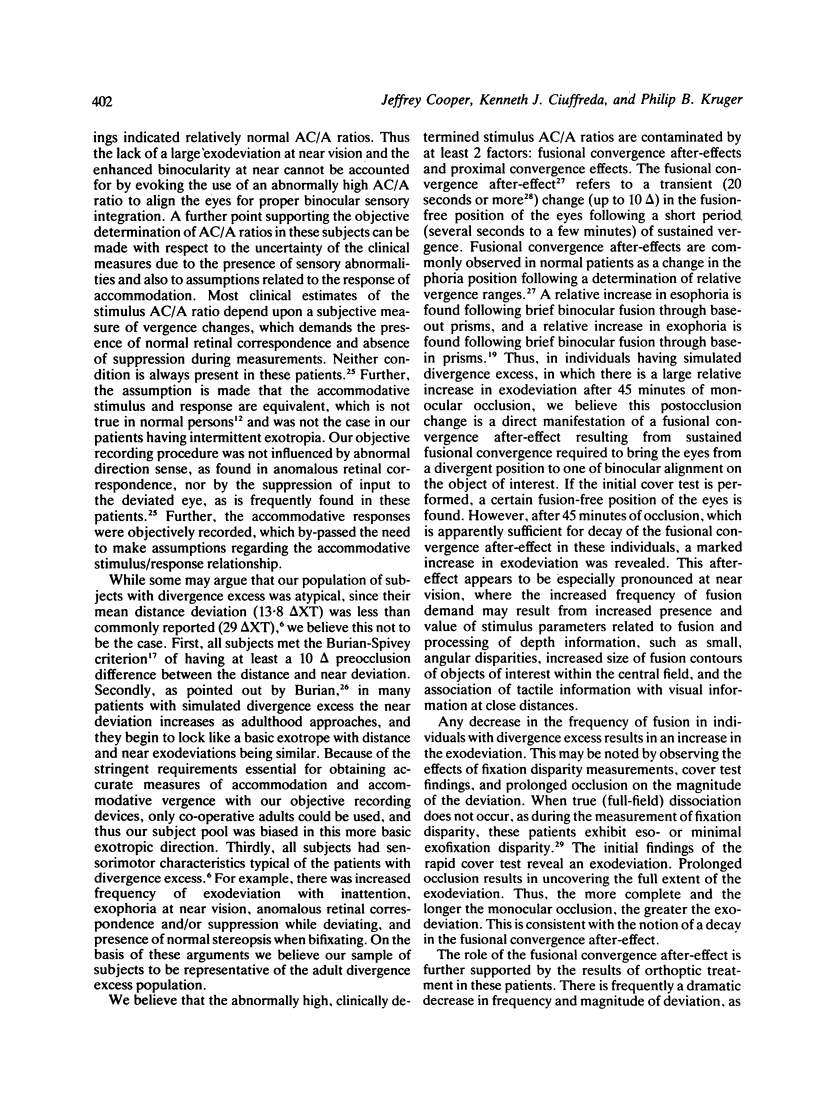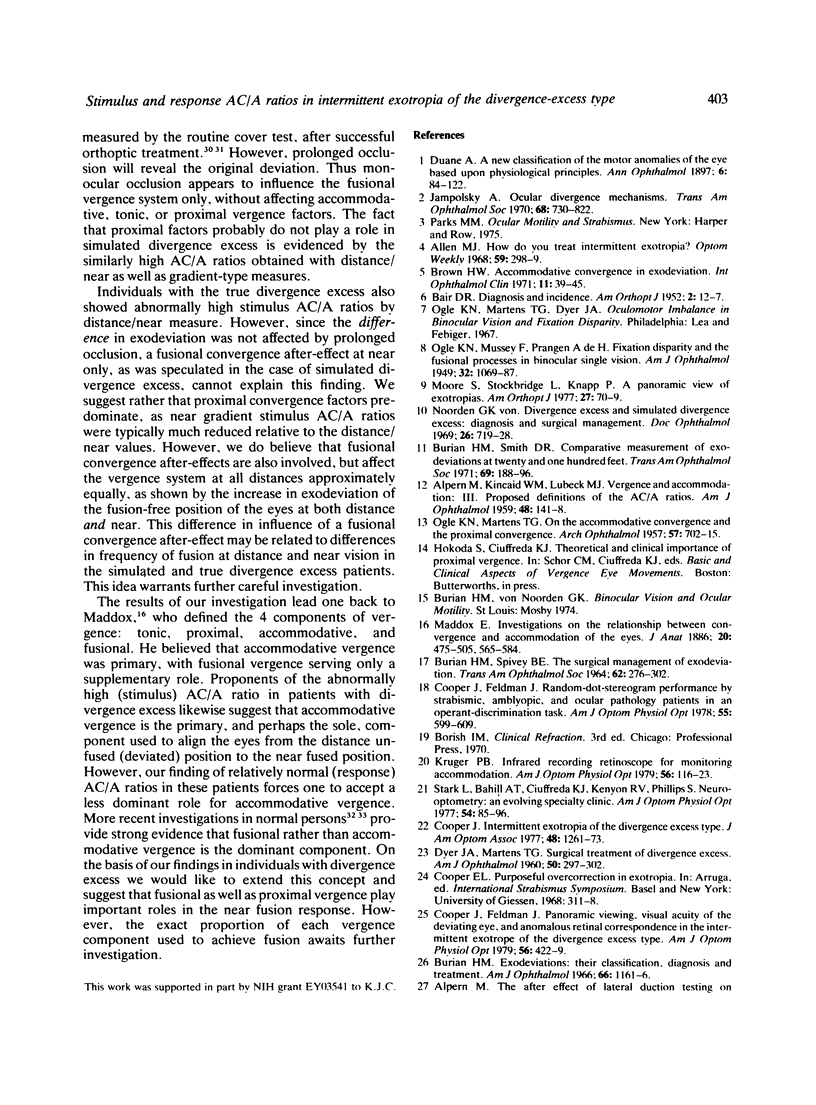Abstract
Objective infrared recording devices were used to measure simultaneously and continuously both accommodation and accommodative vergence to near stimuli in 4 subjects with intermittent exotropia of the divergence-excess type (2 simulated and 2 true). In addition standard clinically determined stimulus accommodative convergence to accommodation (AC/A) ratios were measured. Results showed the mean group response AC/C ratio to be 5.9/1 (range 4.5-8.0/1) with no differences between true and simulated divergence-excess. Similar AC/A ratios were found after 45 minutes of monocular occlusion. Our results clearly demonstrate relatively normal response AC/A ratios in these subjects. Thus, contrary to what is believed by many clinicians, the reduced ocular deviation at near compared with distance vision cannot be attributed primarily to an abnormally high AC/A ratio. We believe than fusional convergence after-effects and/or proximal convergence effects contribute to inflate the clinically determined stimulus AC/A ratios.
Full text
PDF






Selected References
These references are in PubMed. This may not be the complete list of references from this article.
- ALPERN M., KINCAID W. M., LUBECK M. J. Vergence and accommodation. III. Proposed definitions of the AC/A ratios. Am J Ophthalmol. 1959 Jul;48(1 Pt 2):141–148. doi: 10.1016/0002-9394(59)90252-1. [DOI] [PubMed] [Google Scholar]
- BAIR D. R. Intermittent exotropia; diagnosis and incidence. Am Orthopt J. 1952 Sep;2:12–17. [PubMed] [Google Scholar]
- BURIAN H. M., SPIVEY B. E. THE SURGICAL MANAGEMENT OF EXODEVIATIONS. Trans Am Ophthalmol Soc. 1964;62:276–306. [PMC free article] [PubMed] [Google Scholar]
- Brown H. W. Accommodative convergence in exodeviation. Int Ophthalmol Clin. 1971 Winter;11(4):39–45. doi: 10.1097/00004397-197101140-00007. [DOI] [PubMed] [Google Scholar]
- Burian H. M. Exodeviations: their classification, diagnosis and treatment. Am J Ophthalmol. 1966 Dec;62(6):1161–1166. doi: 10.1016/0002-9394(66)92570-0. [DOI] [PubMed] [Google Scholar]
- Burian H. M., Smity D. R. Comparative measurement of exodeviations at twenty and one hundred feet. Trans Am Ophthalmol Soc. 1971;69:188–199. [PMC free article] [PubMed] [Google Scholar]
- Cooper J., Feldman J. Panoramic viewing, visual acuity of the deviating eye, and anomalous retinal correspondence in the intermittent exotrope of the divergence excess type. Am J Optom Physiol Opt. 1979 Jul;56(7):422–429. doi: 10.1097/00006324-197907000-00003. [DOI] [PubMed] [Google Scholar]
- Cooper J., Feldman J. Random-dot-stereogram performance by strabismic, amblyopic, and ocular-pathology patients in an operant-discrimination task. Am J Optom Physiol Opt. 1978 Sep;55(9):599–609. doi: 10.1097/00006324-197809000-00001. [DOI] [PubMed] [Google Scholar]
- Cooper J. Intermittent exotropia of the divergence excess type. J Am Optom Assoc. 1977 Oct;48(10):1261–1273. [PubMed] [Google Scholar]
- DYER J. A., MARTENS T. G. Surgical treatment of divergence excess. Am J Ophthalmol. 1960 Aug;50:297–302. [PubMed] [Google Scholar]
- FINCHAM E. F., WALTON J. The reciprocal actions of accommodation and convergence. J Physiol. 1957 Aug 6;137(3):488–508. doi: 10.1113/jphysiol.1957.sp005829. [DOI] [PMC free article] [PubMed] [Google Scholar]
- Goldrich S. G. Oculomotor biofeedback therapy for exotropia. Am J Optom Physiol Opt. 1982 Apr;59(4):306–317. doi: 10.1097/00006324-198204000-00004. [DOI] [PubMed] [Google Scholar]
- Goldrich S. G. Optometric therapy of divergence excess strabismus. Am J Optom Physiol Opt. 1980 Jan;57(1):7–14. doi: 10.1097/00006324-198001000-00002. [DOI] [PubMed] [Google Scholar]
- Jampolsky A. Ocular divergence mechanisms. Trans Am Ophthalmol Soc. 1970;68:730–822. [PMC free article] [PubMed] [Google Scholar]
- Kruger P. B. Infrared recording retinoscope for monitoring accomodation. Am J Optom Physiol Opt. 1979 Feb;56(2):116–123. doi: 10.1097/00006324-197902000-00008. [DOI] [PubMed] [Google Scholar]
- LUDVIGH E., MCKINNON P., ZAITZEFF L. TEMPORAL COURSE OF THE RELAXATION OF BINOCULAR DUCTION (FUSION) MOVEMENTS. Arch Ophthalmol. 1964 Mar;71:389–399. doi: 10.1001/archopht.1964.00970010405018. [DOI] [PubMed] [Google Scholar]
- Maddox E E. Investigations in the Relation between Convergence and Accommodation of the Eyes. J Anat Physiol. 1886 Apr;20(Pt 3):475–508. [PMC free article] [PubMed] [Google Scholar]
- Moore S., Stockbridge L., Knapp P. A panoramic view of exotropias. Am Orthopt J. 1977;27:70–79. [PubMed] [Google Scholar]
- OGLE K. N., DYER J. A. SOME OBSERVATIONS ON INTERMITTENT EXOTROPIA. Arch Ophthalmol. 1965 Jan;73:58–73. doi: 10.1001/archopht.1965.00970030060014. [DOI] [PubMed] [Google Scholar]
- Stark L., Bahill A. T., Ciuffreda K. J., Kenyon R. V., Phillips S. Neuro-optometry: an evolving specialty clinic. Am J Optom Physiol Opt. 1977 Feb;54(2):85–96. [PubMed] [Google Scholar]
- Von Noorden G. K. Divergence excess and simulated divergence excess: diagnosis and surgical management. Doc Ophthalmol. 1969;26:719–728. doi: 10.1007/BF00944028. [DOI] [PubMed] [Google Scholar]


